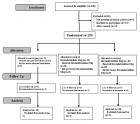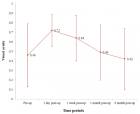Abstract
Research Article
GS-MS Profile, Total Flavonoid and Phenolic Contents and Antioxidant Capacity of Leaves of Vitelleria paradoxa c.f. Gaertn
Theresa Ibibia Edewor*, Amuda Mutiu Olasunkanmi and Stephen Oluwagbemiga Owa
Published: 01 May, 2024 | Volume 8 - Issue 2 | Pages: 043-047
Vitellaria paradoxa is an important medicinal plant that is used for the treatment of infections such as diarrhea, dysentery, helminthes, gastrointestinal tract, skin, and wounds. This research aims to determine other important uses of the plant leaves and quantify the phytochemicals present in the leaves. The plant leaves were extracted with two solvents (n-hexane and methanol). The phytochemicals were qualitatively and quantitatively analyzed using standard methods. The antioxidant activity was determined using DPPH. In the qualitative phytochemical screening of the methanol extract flavonoids, alkaloids, saponins, and tannins were identified as being present while steroids, anthraquinones, and glycosides were absent. All the screened secondary metabolites were absent in the n-hexane extract. In the GC-MS analysis of the methanol and n-hexane extracts seven compounds were obtained from the methanol extract while a total of twenty-four compounds were obtained from the n-hexane extract. The quantitative determination of the total flavonoid and phenolic contents showed that the leaves high content of flavonoids (91.00 mg quercetin equivalent/g extract) and phenolics (91.39 mg Gallic acid equivalent /g extract). These phytochemicals could be responsible for its high antioxidant activity (79.62%).
Read Full Article HTML DOI: 10.29328/journal.jpsp.1001131 Cite this Article Read Full Article PDF
Keywords:
GC-MS; Flavonoid; Phenolic; Antioxidant; Leaves; Vitelleria paradoxa
References
- Newman DJ, Cragg GM, Snader KM. The influence of natural products upon drug discovery. Nat Prod Rep. 2000 Jun;17(3):215-34. doi: 10.1039/a902202c. PMID: 10888010.
- Cox PA. The Seven Pillars of Ethnomedical Wisdom. Ethnobotany. 2005; 17:24-34.
- Evans CE, Banso A, Samuel OA. Efficacy of some nupe medicinal plants against Salmonella typhi: an in vitro study. J Ethnopharmacol. 2002 Apr;80(1):21-4. doi: 10.1016/s0378-8741(01)00378-6. PMID: 11891083.
- Crozier A, Clifford MN, Ashihara H. Plant Secondary metabolites: Occurrence, structure, and role in the human diet. Wiley-Blackwell. 2006. ISBN: 978-18405-12509-3.
- Saeed N, Khan MR, Shabbir M. Antioxidant activity, total phenolic and total flavonoid contents of whole plant extracts Torilis leptophylla L. BMC Complement Altern Med. 2012 Nov 16;12:221. doi: 10.1186/1472-6882-12-221. PMID: 23153304; PMCID: PMC3524761.
- Govind P. Medicinal plants against liver diseases IJPR. 2011; 2:115- 121.
- Byakagaba P. Population structure and regeneration status of Vitellaria paradoxa (C.F) Gaertn under different land management regimes in Uganda. Agricultural Journal. 2011; 6(1):14-22.
- Soladoye MO, Orhiere SS, Ibimode BM. Ethnobotanical study of two indigenous multipurpose plants in the Guinea savanna of Kwara State – Vitellaria paradoxa and Parkia biglobosa. Biennial conference of Ecological Society of Nigeria. Forest Research Institute, Ibadan. 1989; 13.
- Ferry MP, Gessain M, Geeain R. Vegetative propagation of Shea, Kola, and Pentadesma. Cocoa Research Institute, Ghana annual Report (1987/88). 1974; 98-100.
- Heim KE, Tagliaferro AR, Bobilya DJ. Flavonoid antioxidants: chemistry, metabolism and structure-activity relationships. J Nutr Biochem. 2002 Oct;13(10):572-584. doi: 10.1016/s0955-2863(02)00208-5. PMID: 12550068.
- Leopoldini M, Russo N, Chiodo S, Toscano M. Iron chelation by the powerful antioxidant flavonoid quercetin. J Agric Food Chem. 2006 Aug 23;54(17):6343-51. doi: 10.1021/jf060986h. PMID: 16910729.
- Kumar S, Mishra A, Pandey AK. Antioxidant mediated protective effect of Parthenium hysterophorus against oxidative damage using in vitro models. BMC Complement Altern Med. 2013 May 30;13:120. doi: 10.1186/1472-6882-13-120. PMID: 23721571; PMCID: PMC3680177.
- Craig WJ. Health-promoting properties of common herbs. Am J Clin Nutr. 1999 Sep;70(3 Suppl):491S-499S. doi: 10.1093/ajcn/70.3.491s. PMID: 10479221.
- Kumar S, Sharma UK, Sharma AK, Pandey AK. Protective efficacy of Solanum xanthocarpum root extracts against free radical damage: phytochemical analysis and antioxidant effect. Cell Mol Biol (Noisy-le-grand). 2012 Dec 22;58(1):174-81. PMID: 23273209.
- Yao LH, Jiang YM, Shi J, Tomás-Barberán FA, Datta N, Singanusong R, Chen SS. Flavonoids in food and their health benefits. Plant Foods Hum Nutr. 2004 Summer;59(3):113-22. doi: 10.1007/s11130-004-0049-7. PMID: 15678717.
- Miene C, Klenow S, Veeriah S, Richling E, Glei M. Impact of apple polyphenols on GSTT2 gene expression, subsequent protection of DNA and modulation of proliferation using LT97 human colon adenoma cells. Mol Nutr Food Res. 2009 Oct;53(10):1254-62. doi: 10.1002/mnfr.200800444. PMID: 19753602.
- Serra AT, Rocha J, Sepodes B, Matias AA, Feliciano RP, de Carvalho A, Bronze MR, Duarte CM, Figueira ME. Evaluation of cardiovascular protective effect of different apple varieties - Correlation of response with composition. Food Chem. 2012 Dec 15;135(4):2378-86. doi: 10.1016/j.foodchem.2012.07.067. Epub 2012 Jul 20. PMID: 22980816.
Figures:
Similar Articles
-
The Effects of Pharmacological Carbonic Anhydrase Suppression on Defence Responses of Potato Leaves To Phytophthora InfestansMagdalena Arasimowicz-Jelonek*,Jolanta Floryszak-Wieczorek. The Effects of Pharmacological Carbonic Anhydrase Suppression on Defence Responses of Potato Leaves To Phytophthora Infestans. . 2017 doi: 10.29328/journal.jpsp.1001002; 1: 011-025
-
Phytochemical content of leaf and stem of Marsilea quadrifolia (L.)Rajangam Udayakumar*,Karikalan Gopalakrishnan. Phytochemical content of leaf and stem of Marsilea quadrifolia (L.). . 2017 doi: 10.29328/journal.jpsp.1001003; 1: 026-037
-
Physiological impact of Zinc nanoparticle on germination of rice (Oryza sativa L) seedUpadhyaya H*,Roy H,Shome S,Tewari S,Bhattacharya MK,Panda SK. Physiological impact of Zinc nanoparticle on germination of rice (Oryza sativa L) seed . . 2017 doi: 10.29328/journal.jpsp.1001008; 1: 062-070
-
Chlorophylls and xanthophylls of crop plants as dyes for Dye-Sensitized Solar Cells (DSSC)Forni C*,Rossi M,Matteocci F,Di Carlo A. Chlorophylls and xanthophylls of crop plants as dyes for Dye-Sensitized Solar Cells (DSSC). . 2017 doi: 10.29328/journal.jpsp.1001011; 1: 087-094
-
Pharmacological effects of Nephrolepis exaltata L. (fern) aqueous extract on an insect-based model (Nauphoeta cinerea)Sandro Rostelato-Ferreira*,Danrley Mariel Egidio Sanchez,Jocimar de Souza,Yoko Oshima-Franco. Pharmacological effects of Nephrolepis exaltata L. (fern) aqueous extract on an insect-based model (Nauphoeta cinerea). . 2018 doi: 10.29328/journal.jpsp.1001017; 2: 031-036
-
Life history strategies of the armored scale, Aulacaspis alisiana (Hemiptera: Coccoidea: Diaspididae) on the Japanese silver tree Neolitsea sericea (Bl.) Koidz. (Lauraceae) in Fukuoka, JapanCharles AO Midega*,Keiji Takasu. Life history strategies of the armored scale, Aulacaspis alisiana (Hemiptera: Coccoidea: Diaspididae) on the Japanese silver tree Neolitsea sericea (Bl.) Koidz. (Lauraceae) in Fukuoka, Japan. . 2018 doi: 10.29328/journal.jpsp.1001020; 2: 055-058
-
Use of essential oils as new food preservatives (Case: Eucalyptus grandis and Eucalyptus crebra)Sendanyoye Marcel*. Use of essential oils as new food preservatives (Case: Eucalyptus grandis and Eucalyptus crebra). . 2018 doi: 10.29328/journal.jpsp.1001023; 2: 083-090
-
Evaluation of cold response in Ilex paraguariensisCristian Antonio Rojas*,Sandonaid Andrei Geisler,Carina Francisca Argüelles. Evaluation of cold response in Ilex paraguariensis. . 2019 doi: 10.29328/journal.jpsp.1001026; 3: 009-012
-
Cloning and Characterization of a Pseudo-Response Regulator 7 (PRR7) Gene from Medicago Sativa Involved In Regulating the Circadian ClockWeifeng Nian*,Yilin Shen. Cloning and Characterization of a Pseudo-Response Regulator 7 (PRR7) Gene from Medicago Sativa Involved In Regulating the Circadian Clock. . 2019 doi: 10.29328/journal.jpsp.1001032; 3: 056-061
-
Incidence and disease control of Zucchini yellow mosaic potyvirusMahmoud Hamdy Abd El-Aziz*. Incidence and disease control of Zucchini yellow mosaic potyvirus. . 2020 doi: 10.29328/journal.jpsp.1001048; 4: 033-035
Recently Viewed
-
Parents’ perception of the school nurse’s roleDiane Gillooly*,Ganga Mahat,Patricia Paradiso. Parents’ perception of the school nurse’s role. J Adv Pediatr Child Health. 2020: doi: 10.29328/journal.japch.1001021; 3: 064-067
-
Plant growth, Yield and Leaf Nutritional value of Jute (Corchorus olitorius L.) as Influenced by Banana Peel levels under Salt Stress conditions in Coastal region of CameroonMathias Julien Hand*,Chimène Fanta Abib,Kingsley Mbi Tabi,Alphonse Ervé Nouck,Libert Brice Tonfack,Victor Désiré Taffouo,Emmanuel Youmbi. Plant growth, Yield and Leaf Nutritional value of Jute (Corchorus olitorius L.) as Influenced by Banana Peel levels under Salt Stress conditions in Coastal region of Cameroon. J Plant Sci Phytopathol. 2024: doi: 10.29328/journal.jpsp.1001145; 8: 131-140
-
Dynamics of Siberian Fir Stands in Forest Ecosystems of Eastern Sayan SpursBazhina Elena Vasil’evna*,Pavel I Aminev. Dynamics of Siberian Fir Stands in Forest Ecosystems of Eastern Sayan Spurs. J Plant Sci Phytopathol. 2024: doi: 10.29328/journal.jpsp.1001146; 8: 141-143
-
Minimising Carbon Footprint in Anaesthesia PracticeNisha Gandhi and Abinav Sarvesh SPS*. Minimising Carbon Footprint in Anaesthesia Practice. Int J Clin Anesth Res. 2024: doi: 10.29328/journal.ijcar.1001025; 8: 005-007
-
Survey of Advanced Image Fusion Techniques for Enhanced Visualization in Cardiovascular Diagnosis and TreatmentGargi J Trivedi*. Survey of Advanced Image Fusion Techniques for Enhanced Visualization in Cardiovascular Diagnosis and Treatment. J Clin Med Exp Images. 2025: doi: 10.29328/journal.jcmei.1001034; 9: 001-009
Most Viewed
-
Evaluation of Biostimulants Based on Recovered Protein Hydrolysates from Animal By-products as Plant Growth EnhancersH Pérez-Aguilar*, M Lacruz-Asaro, F Arán-Ais. Evaluation of Biostimulants Based on Recovered Protein Hydrolysates from Animal By-products as Plant Growth Enhancers. J Plant Sci Phytopathol. 2023 doi: 10.29328/journal.jpsp.1001104; 7: 042-047
-
Sinonasal Myxoma Extending into the Orbit in a 4-Year Old: A Case PresentationJulian A Purrinos*, Ramzi Younis. Sinonasal Myxoma Extending into the Orbit in a 4-Year Old: A Case Presentation. Arch Case Rep. 2024 doi: 10.29328/journal.acr.1001099; 8: 075-077
-
Feasibility study of magnetic sensing for detecting single-neuron action potentialsDenis Tonini,Kai Wu,Renata Saha,Jian-Ping Wang*. Feasibility study of magnetic sensing for detecting single-neuron action potentials. Ann Biomed Sci Eng. 2022 doi: 10.29328/journal.abse.1001018; 6: 019-029
-
Pediatric Dysgerminoma: Unveiling a Rare Ovarian TumorFaten Limaiem*, Khalil Saffar, Ahmed Halouani. Pediatric Dysgerminoma: Unveiling a Rare Ovarian Tumor. Arch Case Rep. 2024 doi: 10.29328/journal.acr.1001087; 8: 010-013
-
Physical activity can change the physiological and psychological circumstances during COVID-19 pandemic: A narrative reviewKhashayar Maroufi*. Physical activity can change the physiological and psychological circumstances during COVID-19 pandemic: A narrative review. J Sports Med Ther. 2021 doi: 10.29328/journal.jsmt.1001051; 6: 001-007

HSPI: We're glad you're here. Please click "create a new Query" if you are a new visitor to our website and need further information from us.
If you are already a member of our network and need to keep track of any developments regarding a question you have already submitted, click "take me to my Query."

















































































































































